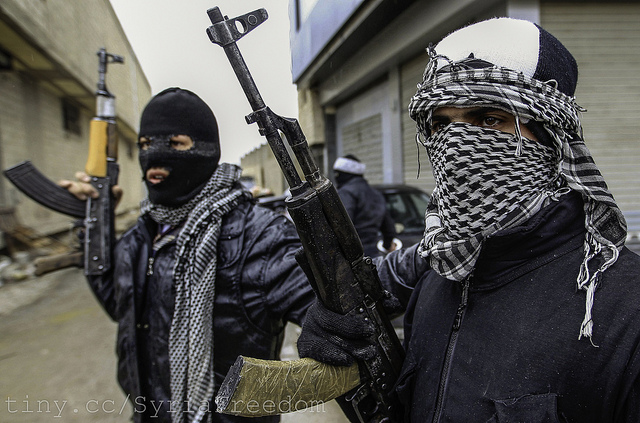 It’s difficult to play down the significance of the current situation in Syria from a counterterrorism perspective. Many felt that the death of Bin Laden, Al-Awlaki and numerous other key members of the al-Qaeda leadership had stemmed the tide of the movement and the global jihad. However, as terrorism issues appear to be slipping down the hierarchy of perceived risks in much of the Western world, the trends that are emerging from the Syrian conflict remind us that al-Qaeda are in this campaign for the long term and still require our attentions at home as well as abroad.
It’s difficult to play down the significance of the current situation in Syria from a counterterrorism perspective. Many felt that the death of Bin Laden, Al-Awlaki and numerous other key members of the al-Qaeda leadership had stemmed the tide of the movement and the global jihad. However, as terrorism issues appear to be slipping down the hierarchy of perceived risks in much of the Western world, the trends that are emerging from the Syrian conflict remind us that al-Qaeda are in this campaign for the long term and still require our attentions at home as well as abroad.
The Arab Spring in early 2011 caught most governments off-guard, as it did al-Qaeda, who were still recovering from the death of their leader and very much in disarray. But before the emergence of a popular movement against the Assad regime, which can be traced back to March 2011, al-Qaeda’s new leader Ayman al-Zawahiri had called upon pious Muslims to support an insurgency against the Syrian leadership. Al-Zawahiri’s message was released in an eight-minute video in February 2011 and was pitched predominantly at Sunni Muslims living in neighbouring Lebanon, Turkey, Jordan and Iraq. Since then the message has spread further afield and the lure of joining the jihad in Syria against a Shia dictator is drawing in young men from across the globe.
Within the complex web of armed civilians, defected soldiers, paramilitary units and militias, the dynamic of growing numbers of foreign militants joining the fight is providing further confusion and danger as they disperse within the different groups present, including the Free Syrian Army, Liwa al-Islam, Katibat al-Ansar, Ahrar al-Sham, and most concerningly Jabhat al-Nusra, which has close linkages with al-Qaeda in Iraq. Accurate estimates of the number of foreign fighters who are present in the country are difficult to come by but there are somewhere between 1500 and 2500. Of course, not all of these are battle-hardened warriors; many have travelled to the region to experience the ‘thrill’ of a war zone, provide assistance in non-combat roles, or want to help because of family ties to the region. But many make the trek with the goal of helping to overthrow the Assad regime.
In this context it’s hard to not draw parallels with the situation in Afghanistan during the mid to late 1980s, when foreign fighters poured into the country to assist in defeating the Soviet forces there. Although they only made up a minority of the jihadists within the fighting force, they capitalised on the training, both ideological and practical, to create the beginnings of the al-Qaeda narrative, sow the seeds of the global jihad and one among them became the group’s figurehead. When focusing on the situation that has developed in Syria, we’d do well to bear history in mind and learn from the mistakes that were made when al-Qaeda went about their business relatively unwatched and unconstrained.
There’s now evidence that jihadists from Chechnya, Algeria, Tajikistan, Pakistan, Xinjiang province in China, Afghanistan, Europe (including the UK), Indonesia and even Australia have been active in Syria. I understand that approximately 100 Australian men have been to or are currently in Syria and involved in the conflict in some form, in either combat or combat support roles. There are obvious security issues for Australia as those individuals return.
Some of these cases have come to light in the press when individuals have been killed, such as Marwan al-Kassab, Roger Abbas and Sheikh Mustapha Al Majzoub who was already known to counterterrorism authorities here. Yet many more remained unnamed and presumably many unmonitored. The Australian government, aware of nationals travelling to Syria, provided a statement by the Australian Federal Police (PDF), in August this year stating that it is illegal for Australians to engage in fighting for either side in Syria, to fund train or recruit someone to fight, or to supply or fund weapons for either side. Yet it appears this warning hasn’t stopped those most highly motivated. Those individuals who gain frontline combat experience in Syria and the ideological extremes and motivations that they bring back with them, are likely to concern Australian authorities. These skills and motivations create a potent magnetism to others interested in the violent jihadist message.
Even if the Assad regime falls sooner rather than later, the jihadist element might already have influence in a post-Assad era. The longer the battle rages within Syria, the more influence the jihadist element will gain. One of the key consequences of this is that against a majority of popular terrorism analysis, the al-Qaeda banner could once again increase its significance, and this has quite dramatic consequences not only in Syria but globally including Australia.
The bottom line is that while governments are busy downgrading the terrorist agenda, new spheres of influence and radical messaging emerge. As anyone who has examined the long-term goals of al-Qaeda and its affiliates will know, theirs is a long-term battle in which a decade is but a fraction of the timescales required to fulfil its objectives. The warning to be heeded is that before any cuts to established counterterrorism capabilities are applied, might happen in times of tight budgets, a greater understanding of the long-term aims of terrorist groups is needed.
Tobias Feakin is a senior analyst at ASPI. Image courtesy of Flickr user FreedomHouse.

